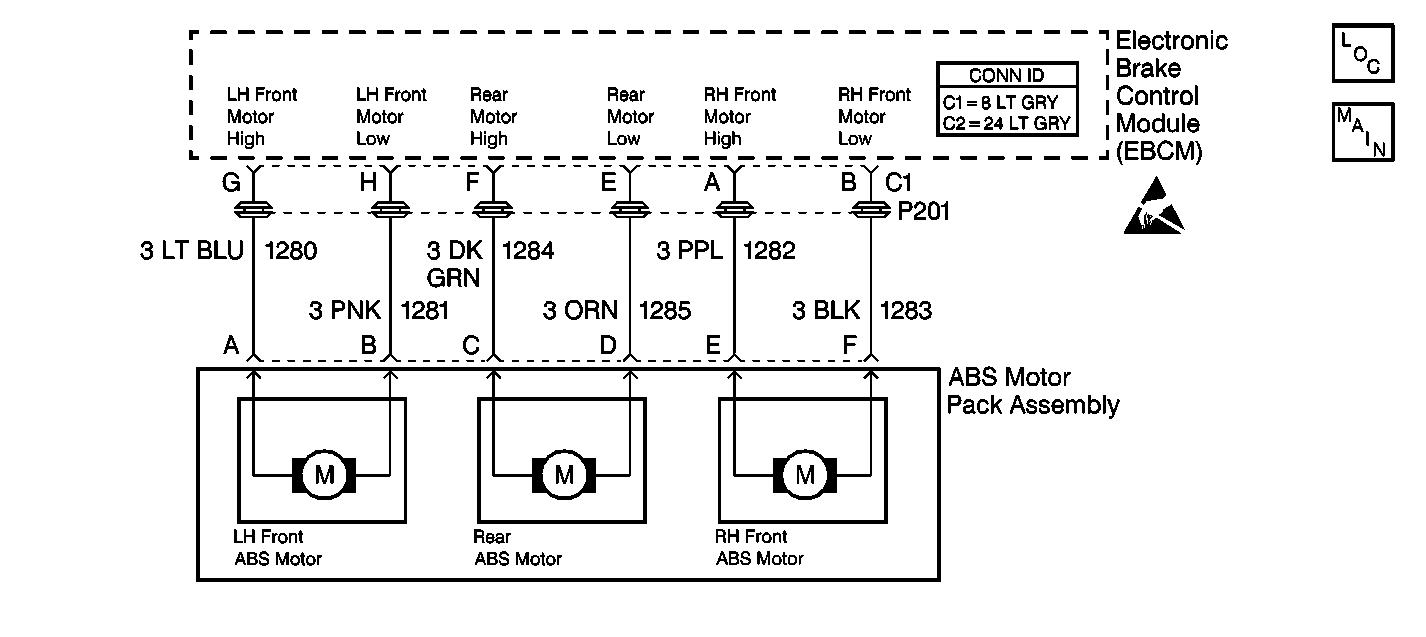
Circuit Description
DTC C1254 diagnoses an ABS motor that energizes longer than expected. The following conditions may cause the longer period of being energized:
| • | A wheel speed sensor malfunctions. |
| • | The ABS motor does not turn. |
| • | The ABS brake motor wires cross. |
Conditions for Setting the DTC
DTC C1254 can only set during an ABS stop.
A malfunction exists if the EBCM commands the rear ABS channel in release for greater than three seconds.
Action Taken When the DTC Sets
| • | A malfunction DTC stores. |
| • | The ABS disables. |
| • | The amber ABS warning indicator turns on. |
Conditions for Clearing the DTC
| • | The condition responsible for setting the DTC no longer exists and the Scan Tool Clear DTCs function is used. |
| • | 100 drive cycles pass with no DTCs detected. A drive cycle consists of starting the vehicle, driving the vehicle over 16 km/h (10 mph), stopping and then turning the ignition off. |
Diagnostic Aids
The following conditions may cause an intermittent malfunction if the conditions exist in a mechanical part of the system:
| • | Sticking |
| • | Binding |
Use the enhanced diagnostic function of the Scan Tool in order to measure the frequency of the malfunction. Use the Scan Tool hydraulic test in order to ensure the total brake system is functional.
Thoroughly inspect any circuitry that may be causing the intermittent complaint for the following conditions:
| • | Backed out terminals |
| • | Improper mating |
| • | Broken locks |
| • | Improperly formed or damaged terminals |
| • | Poor terminal-to-wiring connections |
| • | Physical damage to the wiring harness |
Clear the DTCs after completing the diagnosis. Test drive the vehicle for three drive cycles in order to verify that the DTC does not reset. Use the following procedure in order to complete one drive cycle:
- Start the vehicle.
- Drive the vehicle over 16 km/h (10 mph).
- Stop the vehicle.
- Turn the ignition to the OFF position.
Step | Action | Value(s) | Yes | No | ||||
|---|---|---|---|---|---|---|---|---|
|
Important: Zero the J 39200 test leads before making any resistance measurements. Refer to the J 39200 user's manual. Important: Inspect for and correct the following conditions in the base brake or
suspension system before proceeding with the DTC diagnosis:
| ||||||||
1 | Was the Diagnostic System Check performed? | -- | Go to Diagnostic System Check | |||||
2 |
Do not start the engine. Are there any wheel speed sensor DTCs that set as current DTCs? | -- | Go to the appropriate DTC table. | |||||
3 |
Do any of the wheel speed sensors indicate erratic or intermittent operation? | -- | Go to the Excessive Wheel Speed Sensor Variation DTC for the affected wheel | |||||
4 |
Refer to Lifting and Jacking the Vehicle in General Information. Is it possible to spin each rear wheel freely by hand? | -- | ||||||
5 |
Do not start the engine. Is it possible to freely spin each rear wheel? | -- | ||||||
6 |
Is it possible to freely spin each rear wheel? | -- | ||||||
7 |
Do not start the engine. Do all three of the ABS brake motor pack gears (small gears) spin freely when commanded? | -- | ||||||
8 | Replace the ABS brake modulator. Refer to Brake Modulator/Master Cylinder Assembly Replacement . Is the repair complete? | -- | Go to Diagnostic System Check | -- | ||||
9 | Repair the crossed wires to the rear ABS motor (CKT 1284 and CKT 1285). Is the repair complete? | -- | Go to Diagnostic System Check | -- | ||||
10 | Replace the ABS brake motor pack. Refer to ABS Motor Pack Replacement . Is the repair complete? | -- | Go to Diagnostic System Check | -- | ||||
11 | Repair the source of resistance in the base brake system. Is the repair complete? | -- | Go to Diagnostic System Check | -- | ||||
12 | The malfunction is intermittent or is not present at this time. Refer to Diagnostic Aids for more information. Is the action complete? | -- | System OK | -- | ||||
